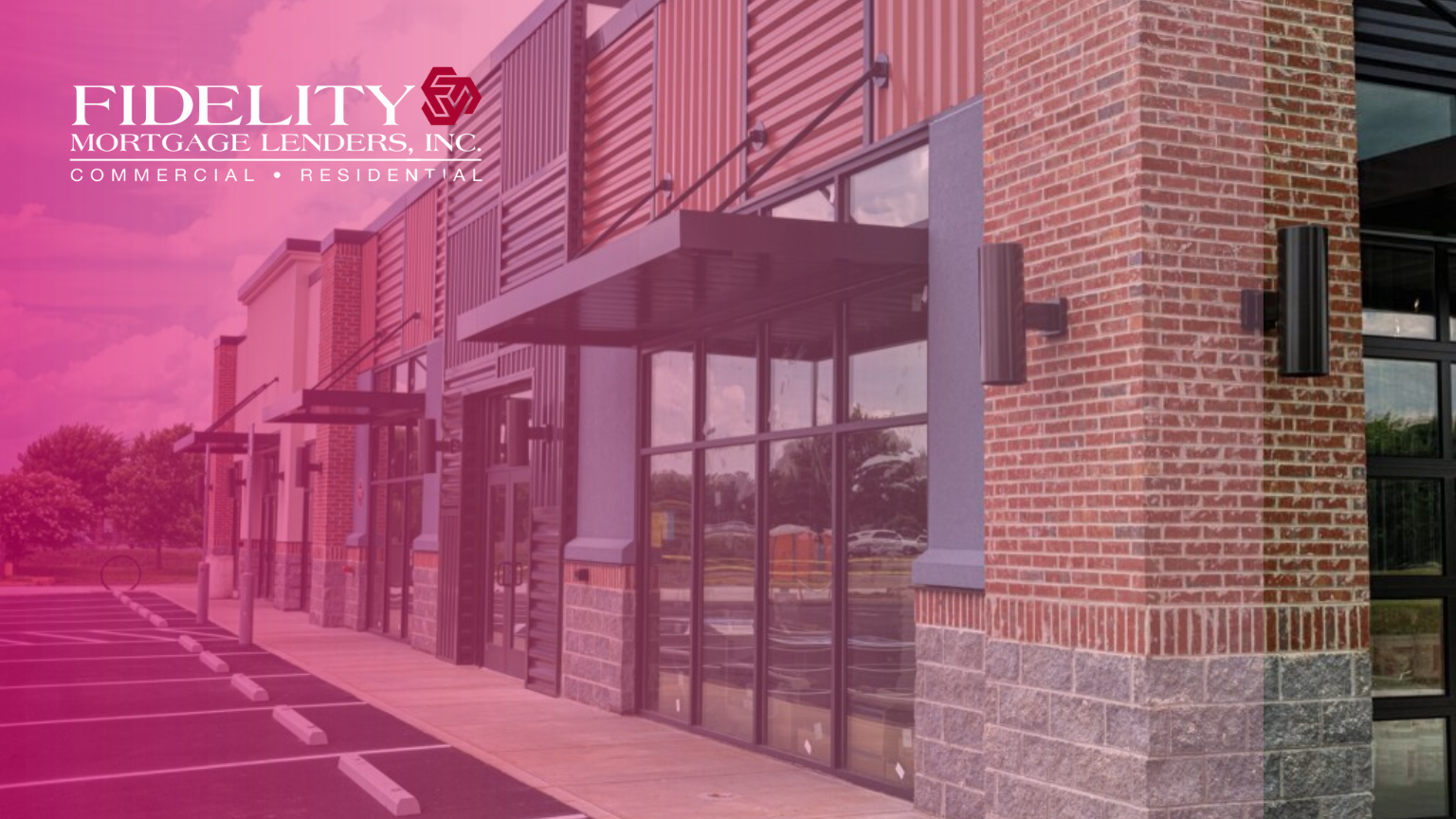A Practical Guide from 15 Years in the Trenches
Owning a commercial property is one of the most critical milestones one can achieve as a business owner/investor. Whether you’re buying office space, retail storefronts, or industrial warehouses, securing the proper financing is often the key to success. Commercial real estate loans, however, are much more complex than residential mortgages.
Mistakes arising from confusion about terms like “amortization schedules,” “debt service coverage ratios”, and “prepayment penalties” can be expensive. With over 15 years of experience in structuring commercial loans, Fidelity Mortgage Lenders has seen savvy investors thrive by understanding these specifics — and unsophisticated ones falter by skimming over them.
We will untangle the key components of commercial real estate loans, offering you actionable insights that can ultimately help you lock in better terms, avoid pitfalls, and ensure your financing supports your long-term goals.
1. Loan Terms: The Foundation of Your Financing
Loan terms outline the financial “rules” of your borrowing agreement. Interest rates, loan term length, and amortization periods are the three critical elements:
Fixed Interest Rates Vs. Variable Interest Rates
Interest rates dictate your monthly payments — and how much your loan will ultimately cost you. There are two rate structures typically available for commercial loans:
- Fixed Rates – Lock in your interest rate for the duration of the loan. These investments offer endurance by protecting you from market volatility. A 10-year fixed-rate loan at 6 percent, for example, allows predictable payments, which is great for long-term investors.
- Variable Rates fluctuate over time depending on an index such as the Prime Rate or SOFR (Secured Overnight Financing Rate). Although initial rates are typically lower, they come with uncertainty. A 5-year ARM that starts at 5.5% could rise to 8% if the economy moves in the wrong direction.
The Federal Reserve’s Commercial Bank Survey shows that the average interest rate for commercial real estate loans was 5.92%, consistent with the effects of the recent tightening of monetary policy.
Loan Term Length: Short-Term vs. Long-Term Commitments
Commercial loans above long-term loans typically have a 5 to 25-year maturity. Because shorter terms (5–10 years) typically have lower rates, but you’ll need to refinance sooner to capitalize on those lower rates, it can be risky to count on refinancing if market conditions tighten.
Longer terms (15–25 years) reduce the frequency of refinancing but are likely to include higher rates or stricter covenants. For example, a 15-year term gives you plenty of equity built up, but if your company intends to flip the property in 7 years, a “balloon payment” structure (i.e., a 5-year loan amortized over 25 years) might serve you better.
Amortization Period: The Hidden Driver of Cash Flow
Amortization is the gradual repayment of the principal balance on your loan. Extended amortization schedules (reducing monthly payments, often with a 25- or 30-year schedule) are also common practice in commercial loans, despite the loan term being short. However, this arrangement can create a balloon payment at the close of the loan term, which is a one-time payment of the remaining dues. For example, refinancing a 2 million balloon payment requires careful cost-benefit analysis to determine if savings from a new loan outweigh refinancing expenses.
As another example, think that you have a $1 million 10-year loan that has a 25-year amortization table. Your monthly payments would be on a 25-year amortization schedule (about $5,846 at 6 percent interest). But a decade later, you’d still owe about $838,000.
Not planning for this balloon payment can create more damaging financial processes, including selling assets in haste or refinancing the loan in less-than-ideal terms.
2. Loan Conditions: The Strings Attached
Lenders mitigate risk by embedding conditions into loan agreements. These clauses protect their interests but can limit your flexibility if overlooked.
Prepayment Penalties: The Cost of Early Exit
Loan Terms: The Fine Print
To manage that risk, lenders insert conditions into loan agreements. Be mindful that their interests are very well protected, and these clauses can limit your flexibility if not considered.
Prepayment Penalties: Fees for Getting Out Early
Prepayment penalties discourage borrowers from early repayment of loans (and lenders from the interest they expect to earn). There are two common structures:
- Yield Maintenance: A fee that compensates the lender for lost interest; can be calculated as the present value of remaining payments.
- Step-Down Penalties: These are percentages that drop each subsequent year (e.g., 5% of the balance in year 1, 4% in year 2).
Covenants: Financial Guardrails
Loan covenants, however, are contractual obligations that require you to keep certain financial metrics in line. Common examples include:
- Debt Service Coverage Ratio (DSCR): Your net operating income (NOI) is divided by annual debt payments. Lenders usually want a DSCR of at least 1.25x, which means your NOI must be 25% greater than your debt payments.
- Loan-to-Value (LTV) Ratio: The percentage of the property’s appraised value that the loan amount represents. Commercial properties usually have an LTV limit of 75–80%, requiring a 20–25% down payment with most lenders.
Default can be triggered by breaching covenants, even if you are making payments. The FDIC reported that 0.56% of non-owner-occupied commercial loans were delinquent back in 2022, and these were mostly the result of a covenant breach and not a payment default.
Collateral Requirements: Beyond the Property
Though it is the property itself that serves as the primary collateral, lenders might also ask for further guarantees:
- Cross-Collateralization: Offering other business assets (e.g., equipment, inventory) to pledge as backup collateral.
- Personal Guarantees: These make borrowers personally liable if the company defaults.
We once counseled a client whose lender wanted a personal guarantee on a $3 million warehouse loan.
And when the business struggled during a recession, the lender came after the owner’s personal assets — a risk that could have been avoided with better upfront negotiation.
3. Eligibility Requirements: Proving You’re a Safe Bet
Lenders look for four types of eligibility: creditworthiness, cash flow, equity, and business viability.
Credit Score: Your Passport to Financing
Although residential mortgages sometimes accept scores as low as 580, commercial lenders generally require a minimum FICO score of 680. The low scores may result in higher rates or requests for more collateral.
Cash Flow: Key to Making Debt Repayments
Lenders examine your company’s past and future cash flow. The G.B. programs, for instance, credit the “adequate liquidity” requirement in the S.B.A.’s 7(a) loan program, which requires borrowers to show they have enough cash post-closing to pay expenses should their revenue drop.
Equity: Skin in the Game
The standard down payment for a mortgage is 20–25%, although lenders can ask for more if the property is high-risk (i.e., hotels, startups). The SBA 504 program, which finances owner-occupied commercial properties, requires as little as a 10% down payment by combining a bank mortgage with an SBA-guaranteed portion.
Final Thoughts
The secret to understanding commercial loan terms isn’t just about getting financing; it’s about timing your debt alongside the trajectory of your business. A well-structured loan can deliver the leverage you need to scale, while a poorly negotiated loan can fetter growth.
Always check with a commercial real estate attorney or financial adviser before signing anything. It will continue to be important to stay in touch with changes in the market so your investments remain strong.
For more personalized guidance, visit Fidelity Mortgage Lenders to explore how we can help you navigate the complexities of commercial loans and achieve your business goals.
Comments are closed.







